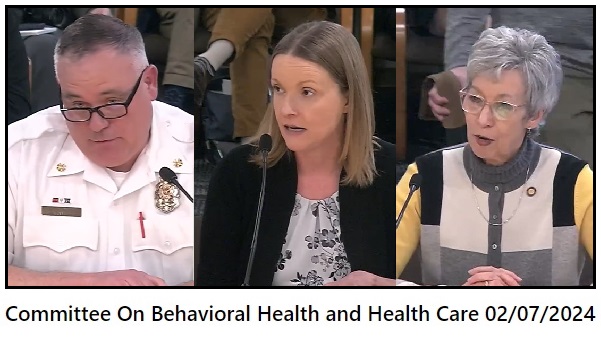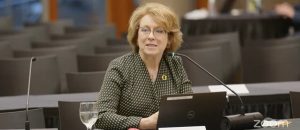Local officials testify, support emergency funding after loss of Eugene hospital
9 min read
Eugene’s top legislative priority gets a public hearing. On Feb. 7:
Ethan Nelson (Eugene IGR manager): What I’ll focus in on is (Eugene City) Council’s top priorities. Related to the University District (hospital) closure and the emergency response funding, the bill is HB 4136, and the leadership on that is with Rep. (Nancy) Nathanson.
[00:00:24] And today there’s a public hearing for the bill at 3 o’clock. Deputy (Fire) Chief (Chris) Heppel is going to attend, and we’ve got a panel of Rep. Nathanson, Paige Spence from the Oregon Nurses Association and then Chief Heppel and then also Eve Grey from Lane County Health and Human Services is going to be presenting, to talk a little bit about what the county’s thinking related to some of the innovation funds that would be directed towards the county and that ideally the city would be eligible for.
[00:0:55] Rep. Nancy Nathanson (Feb. 7, 3 p.m. public hearing): I am Nancy Nathanson, state representative from District 13. First of all, I want to thank Rep. (Charlie) Conrad and a few other colleagues who have helped me working on this bill.
[00:01:11] On Aug. 22, we heard that Eugene would lose its only hospital and emergency department with 90 days notice. The hospital served as an entryway for immediate access to medical and behavioral health care, both emergency and non-emergency, and is located in the University of Oregon neighborhood. The closure would leave a gap in the community’s access to care.
[00:01:31] My co-sponsors and I are bringing you this bill to request relief for Eugene’s extraordinary costs of meeting a sudden new demand in emergency medical response. And we ask for the state to help us by participating in seizing an opportunity to do things differently, finding innovative ways to deliver quick care to people who need it—compassionate, timely, appropriate, and cost-effective.
[00:01:58] We think there are ways to alleviate the strain on hospital emergency departments, get care to people who need it, and doing it all in a way that can bring down overall system costs.
[00:02:12] Paige Spence (ONA): My name is Paige Spence and I am the director of government relations for the Oregon Nurses Association. I appreciate the opportunity to speak in support of House Bill 4136 and I will be brief.
[00:02:23] In August 2023, as you heard, PeaceHealth announced the relatively abrupt closure of the Sacred Heart Medical Center University District Hospital in Eugene. And there was the transfer of some services, but also the reduction of many services which left the community little opportunity for the regional health care system to really adjust and also really increase the strain on our nurses who work at Sacred Heart RiverBend since they began, as you’ve heard, to receive those additional patients.
[00:02:50] Our members who work at Sacred Heart RiverBend are still really acutely experiencing the aftermath of this closure: long wait times in the ED (Emergency Department), but also long wait times to discharge patients from the ambulance to the ED. And, of course, many patients coming to the emergency department for treatment of non-emergent medical or social care.
[00:03:08] We very much applaud Rep. Nathanson’s efforts to find solutions for the ongoing health care delivery deficit in her district. In particular, our nurses have been sitting in coalition with some of these other first responders that you’ve heard from, faith leaders and community members, and came forward with strong recommendations of many of the programs that could be funded by the innovation fund in this bill.
[00:03:28]Additionally, enabling the State Board of Nursing to provide a provisional license when a nurse applies to work in the state under certain circumstances, supports staffing needs by streamlining the process for Oregon employers to hire nurses from other states thereby enhancing the state’s health care responsiveness and ensuring that we have a strong nursing workforce in Eugene and other communities where needed.
[00:03:48] We also particularly appreciate that that provision of the bill would not allow for nurses to be brought in for other states for the express purpose of strikebreaking. We urge an ‘Aye’ vote and thank you again for the opportunity to provide comment.
[00:04:01] Chris Heppel, Eugene Springfield Fire deputy chief: I’m Deputy Chief Heppel. I am the deputy chief of emergency medical services for Eugene Springfield Fire (ESF).
[00:04:10] ESF is the largest government-based ambulance provider in the state of Oregon. We not only cover Eugene Springfield metro area, but seven contracted fire districts around the metro area and seven rural fire protection districts, which is approximately 370,000 residents of Lane County. This generates around 37,000 EMS calls and 25,000 transports annually between us and our Mid-Valley (Ambulance) non-emergency contracted provider.
[00:04:33] Our EMS system has been stressed for years, both in resources and financially. Over the last few years, we’ve been further stressed by our inability or challenges with offloading our patients at our emergency rooms. We refer to this as APOT, or Ambulance Patient Offload Time.
[00:04:47] In 2023, we saw a 14.4% increase in our APOT time and it has been increasing over the last few years. This reduces availability of units in the street. It’s uncomfortable for patients sitting on our gurneys and stressful for EMS crews who spend hours standing on a wall.
[00:05:03] The closure of PeaceHealth University District was abrupt with its little notice and immediately generated increased consumption of EMS unit availability. Travel to the hospital was distant. APOT times increased, travel back to their first-due areas increased as well. These patients originating in Eugene, who would’ve gone to University District, added 27 to 30 minutes per transport, which is approximately 2,000 unit-hours a year.
[00:05:28] This also impacted on McKenzie Willamette Hospital and drove their capacity even higher, and we’re experiencing similar issues with McKenzie Willamette,
[00:05:37] The reduction of ER beds, ER physicians, nurses was truly felt during the January ice storm. Not only that, it decreased safety for our crews having to drive further.
[00:05:46] January 2024 tied the highest month for total APOT time, only with December 2023 being second. So we’re not seeing any improvement there at all.
[00:05:56] It’s not just a Eugene Springfield Fire problem. Programs such as our well-known CAHOOTS program, law enforcement, other ambulance services also bring thousands of patients annually to the back door of these two hospitals.
[00:05:58] Our additional BLS unit that’s in the bill would provide 12 hours of additional unit time daily, which is about a 10% increase in our daytime staffing to help blunt the increase in unit utilization associated with the hospital closure. We’re not purchasing an ambulance and we’re going to utilize current staff to staff this unit.
[00:06:23] The innovation idea is just fantastic. Our organizational goal has always been: ‘The right patient, right response, right level of care, right mode of transportation, to the right destination.’ Currently, no system is in place for medical responses after the 911 call has been generated. We had no choice but to send an ambulance or fire trucks.
[00:06:40] Other ideas around piloting innovations could be such as real-time 911 call diversion as we’ve seen in the state of Colorado—there’s a pilot program going on there—and there are a number of other examples across the United States. We might see a community aid response for Eugene, Springfield, or ‘Cares Car’ which is staffed with two individuals in a smaller vehicle, and certainly a senior live-in response unit might be some innovation ideas that could be utilized.
[00:07:07] In Lane County, we work collaboratively daily with our hospital and public health partners to align community members’ needs with their rights. This bill represents that continued collaboration by allowing some innovation to be piloted and potentially replicated elsewhere in Oregon.
[00:07:20] Eve Gray (Lane County Health and Human Services): My name is Eve Gray and I am the Director of Health and Human Services for Lane County.
[00:07:26] I’m speaking today in support of House Bill 4136. As you’ve heard, in August Eugene-area residents were notified of the impending closure of University District Hospital. As the community grappled with the realization that this important resource that had served our community for about 100 years would no longer be available, Rep. Nathanson convened community leaders to discuss how to protect access to health care in our community.
[00:07:52] Through these meetings, all agreed that gaps in the health care system were likely, especially given that local EDs were already frequently overwhelmed and had long wait times. And yet hospitals were identifying numerous utilizers of the emergency department who did not require a hospital level of care…
[00:08:07] We recognize that there continues to be unnecessary ED utilization in our community and communities across the state, especially amongst un- and underinsured individuals who have few other health care options.
[00:08:19] The innovation fund in this bill will allow our community to pilot programs to reduce unnecessary ED, 911, and ambulance utilization by providing alternative and less-costly options for health care access to share those and then share those lessons learned via OHA (Oregon Health Authority) with the rest of Oregon.
[00:08:38] Oregon has long been committed to achieving the triple aim of improving quality and satisfaction in health care while decreasing costs. Through this bill, we address the immediate term needs to stabilize local emergency health care in Lane County. Given that we have one less hospital, we also see an opportunity to vision a future where health care relies less on emergency response and is better equipped to provide the right health care in the right setting at the right time.
[00:09:02] Courtney Johnston (Trillium): My name is Courtney Johnston. I’m the senior director of government relations for Trillium Community Health Plan, and we serve about 38,000 members in Lane County and western Douglas County. We’ve been serving Medicaid members in that community for over 20 years, and I’m just here today to support this bill…
[00:09:18] I want to speak to what a pleasure it is working with all the providers and community members and stakeholders in Lane County. I really have been so heartened with the dedication and ingenuity I see in this community when we come together to solve problems.
[00:09:30] I think with the present circumstances in this community and the nature and dedication of the stakeholders you’ve heard from here today, we have an opportunity to develop something that can be shared and adopted in other communities in the state.
[00:09:43] Tom Holt (Oregon Health Leadership Council): Tom Holt appearing for the Oregon Health Leadership Council. It is a collaborative of all the major provider organizations and payers in the state, and they work on kind of system-wide things.
[00:09:57] You hear from us most often here about data. But they’re very excited to hear about this initiative. (Okay.) It has, as you heard, a lot of potential to ‘test sled’ and find things that we could do elsewhere in the state to help some relieve pressure on emergency rooms, but more important, deliver better care to patients. So, very excited to say we support this enthusiastically and look forward to working with the community going forward.
[00:10:29] John Q: With no opposition at the public hearing, the next step for the bill is a committee vote.
[00:10:37] Ethan Nelson (Eugene IGR manager): We’ve also spent time, we’ve had meetings with every single member of the Health Care Committee, talked to them both sides of the aisle, and had broad support for the bill.
[00:10:49] We believe it’ll get out of committee soon and it will likely go to Ways and Means. And so then we will start having conversations with the subcommittee that it heads to, which is likely Human Services. And that’s when then the funding component part starts. And so we’re identifying how to talk with budget writers, leverage our leadership positions from our delegation, and ensuring that it gets written on into the final budget bill, ideally, and funding gets allocated.
[00:11:16] We won’t know that more than likely until the end of the legislative session, March 10 or so.
[00:11:21] John Q: Local officials collaborate with Rep. Charlie Conrad and Rep. Nancy Nathanson to introduce HB 4136, after the state’s second-largest city loses its only hospital. Their proposal could become a model for the future of health care.



